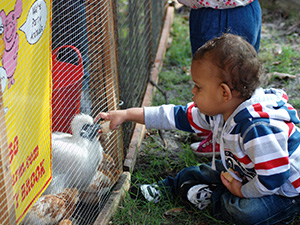Fun with animals – Baby
 Babies are fascinated by animals. Real animals hold a baby’s attention for longer than toys. Very young children are able to respond to animal movements and sounds; following them with their eyes and making sounds in response to them.
Babies are fascinated by animals. Real animals hold a baby’s attention for longer than toys. Very young children are able to respond to animal movements and sounds; following them with their eyes and making sounds in response to them.
Did you know?
Babies focus on real animals for longer than toys. Your baby’s natural interest in animals makes them useful to inspire learning and development e.g. learning to crawl after a cat or dog.
Add language
Your baby’s interest in animals can be a focus for building language skills. Animals are great conversation starters. You could name the animal and have fun together making the animal’s sound. Remember to pause and give your baby a chance to make a noise or take a turn.
Other development
As your young baby’s eye sight develops they will begin to notice the movement of birds and animals moving around them. Following the movement of a bird in flight or a kangaroo moving away helps to develop eye movements (known as tracking).
Variations
Enjoy discovering the different animals you come across when you go for a walk around your local area. Look out for times when your baby shows you they are interested in something they have seen or heard. They might show interest by pointing, making gestures or making a sound.
Safety
Even well-known animals can be unpredictable, as are babies. Close adult supervision reduces health and safety risks to both your baby and the animal.
Activities listed under “baby” are suitable for children under 12 months. This age is largely about babies exploring their own bodies and the world around them from the safety of a close relationship with their caregiver.

